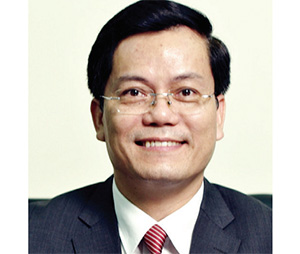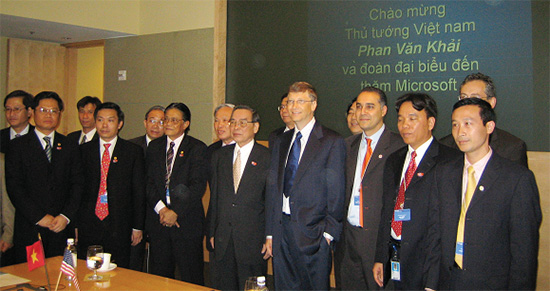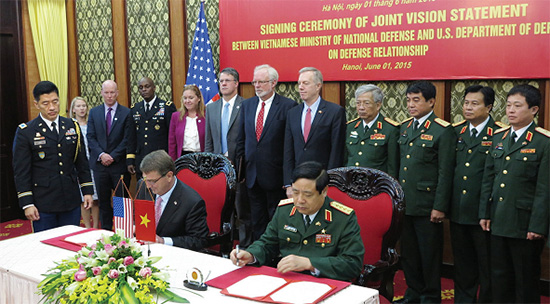At a press briefing following bilateral talks with US President Barack Obama on July 7, 2015, Vietnam Party General Secretary Nguyen Phu Trong stated that it is rare for two nations to change from former enemies to become friends, partners, and even comprehensive partners after only 20 years of diplomatic relations, as the US and Vietnam have done. The two nations “have been able to rise above the past to overcome differences, to promote our shared interests, and look towards the future in order to build the comprehensive partnership that we have today”.
 |
| Ha Kim Ngoc Deputy Minister of Foreign Affairs |
20 years of normalised ties
The 20-year journey since Vietnam and the US forged diplomatic relations on July 12, 1995 is not long in terms of the overall course of history. In this relatively brief period, the two nations have made spectacular strides forward, weathering a myriad of difficulties and scoring many major achievements.
Vietnam and the US became trade partners in 1995, and then comprehensive partners in 2013, during the official visit to the US by Vietnamese State President Truong Tan Sang. In July 2015, Party General Secretary Nguyen Phu Trong also made a historic visit to the US.
The two consecutive visits within two years marked a milestone that could not have been imagined by insiders 20 years ago. The visits demonstrate the two sides’ tireless efforts in building up mutual trust and fostering co-operation.
In terms of size, ties between the US and Vietnam have risen above a level of bilateral co-operation to reach a higher level of “triple co-operation” including bilateral, regional, and global co-operation.
The two nations’ bilateral trade hit $45 billion last year, a 100-fold increase from only $451 million in 1995. After the Bilateral Trade Agreement (BTA) was signed, trade turnover between the two has steadily grown 20 per cent per year, including in the period from 2008-2009 when the world was mired in financial crisis. This sustained growth has turned the US into one of Vietnam’s largest export markets. The two sides have also committed to collaboration in a wide range of sectors, such as defence and security, science and technology, health, humanitarian aid, culture, and education.
At present, almost 17,000 Vietnamese students are studying in the US, ranking first among ASEAN and eighth among all nations with students in the US. Student exchanges further strengthen relations between the two nations’ localities and people, helping enhance mutual understanding on both sides.
Regionally, the US, Vietnam, and ten other nations have concluded negotiations on the Trans-Pacific Partnership (TPP) – a new generation framework for trade liberalisation in the Asia-Pacific region. In its capacity as an active and responsible member of ASEAN, Vietnam has also contributed to boosting the ASEAN-US Strategic Partnership, and worked with the US and other relevant nations to promote the central role of ASEAN.
Along with other countries, Vietnam and the US have also worked together to foster peace and stability in the East Sea and manage the development of the Mekong River basin in an effective and sustainable manner.
In a broader context, Vietnam and the US have deepened their collaboration in multilateral and international fora, actively contributing to peace, security, stability, and sustainability across the globe in areas including peacekeeping operations, anti-terrorism, cybersecurity, prevention of epidemics, natural calamities, and climate change response.
The process of building up trust between the two sides has seen huge steps forward in recent years. Vietnam and the US have conducted frequent discussions about complicated, diverse issues. The differences in political institutions and levels of development, as well as different viewpoints on major world and regional events are huge challenges for the nations’ bilateral relations.
 |
|
Prime Minister Phan Van Khai visited Microsoft during his official trip to the US in 2005
|
However, over the past 20 years, the two countries have overcome many obstacles that once seemed irreconcilable. Dialogues on sensitive topics, such as human rights, have been maintained in a straightforward, constructive, and open-minded manner, in order to clarify the two nations’ views and facilitate co-operation in other areas.
The past has been relegated to the history books. Current achievements will be celebrated, and the comprehensive partnership between Vietnam and the US will move towards a bright future, based on the lesson of “rising above the past to overcome differences, to promote our shared interests, and look towards the future”, in order to build friendship and equality between the two countries for the sake of their people, and for peace and stability in the region and throughout the world.
 |
|
The two sides signed the Joint Vision Statement on Defense Relations in 2015
|
The road ahead
It is clear that there is a huge opportunity for the sustainable and effective development of relations between Vietnam and the US.
The Asia-Pacific region is forecast to continue as the most dynamic and rapidly-developing area in the world. The region is also seeing some conflicts of interest, including prolonged territorial disputes that are quite complicated and difficult to solve.
In this context, the US will continue prioritising its commitments and co-operation with the region.
As for Vietnam, a key member of ASEAN and a medium-sized nation in the region, the country will continue expanding its co-operation with major world powers (including the US) in order to boost its economic development and promote its role as an important and reliable trade partner for other nations.
The fact that Vietnam and the US are strengthening their multi-faceted relations suits the current trend of globalisation and regionalisation, and will allow international integration to continue developing smoothly.
With a rise in global and regional issues that cannot be addressed by a single nation, there is also an increase in interdependence and interlocking interests among countries in the world today.
Vietnam-US relations are increasingly important in the Asia-Pacific region, and are linked with global and regional issues that the two nations are working to resolve, such as the safety and freedom of navigation and aviation, respect for international law, non-militarisation in the East Sea, effective enforcement of the Trans-Pacific Partnership, response to climate change, and construction of a positive and stable regional structure.
Thus, co-operation between the US and Vietnam will prevail, promoting the two nations’ sustainable, stable, and long-lasting ties.
That said, the two countries, however, face certain obstacles which need to be overcome. For example, Vietnam and the US have different stances on democracy, human rights, and freedom of religion. These issues are sometimes distorted in order to obstruct further collaboration between the nations.
In addition, differences in political regimes and levels of development will create impediments to the two countries’ efforts to enhance their mutual understanding.
Nevertheless, based on the lessons learned over the last 20 years and given the foundation of the bilateral relations, we can affirm that although some divergence in views remains, the differences will be narrowed down gradually to a level that the two sides can manage, while still ensuring the development of these relations.
Most importantly, the two sides must continue implementing strong measures to foster mutual trust and understanding, with respect for each nation’s political institutions and development models.
With their robust determination to continue improving bilateral relations, the development of relations between Vietnam and the US in the years to come will not only serve the best interests of the two nations’ peoples, it will also actively contribute to maintaining peace, stability, and prosperous development throughout the region.
VIR